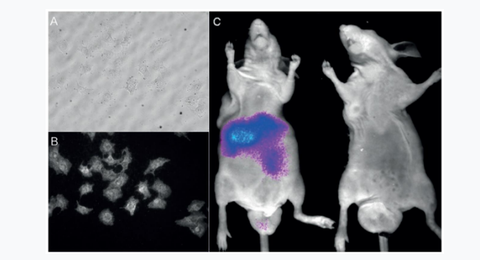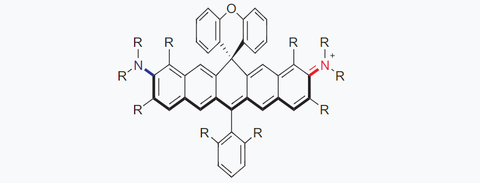Near-infrared fluorescent dyes are widely used in fluorescence imaging, photothermal and photodynamic therapy, solar photosensitive cells, etc. EC series near-infrared fluorescent dyes are a new type of high-performance dyes developed by the team of Professor Yang Youjun of East China University of Science and Technology. The maximum absorption wavelength is in the near-infrared range. By changing the structure of the push-pull electronic functional group in the dye core, the maximum absorption wavelength of this series of dyes can be adjusted within the range of 640-920 nm, meeting the needs of infrared imaging, photothermal ablation and other applications in the biomedical field. Using self-built fluorescence microscopy equipment, fluorescence imaging of cells or living organisms can be performed (Figure 1).

figure 1 The fixed HeLa cells loaded with ECXb (10 mm) imaged under white-light (A) and under excitation by an 808 nm laser (B). Overlay of the fluorescence and white light images of nude mouse with (C, left) and without (C, right) injection of ECXb via the tail vein.
The photophysical properties of EC series dyes have been calibrated by HORIBA, Hamamatsu and other companies, and can be used as standard dyes for the determination of fluorescence quantum yield of infrared dyes.
Compared with traditional cyanine near-infrared fluorescent dyes (such as Cy5, indocyanine green), EC series dyes have obvious advantages in key indicators such as absorption and emission wavelength, fluorescence intensity, photostability, and environmental sensitivity:
Narrow spectral peaks and high fluorescence intensity: Classic cyanine dyes such as Cy5 and Cy5.5 have a large degree of structural freedom due to the push-pull electron conjugated chain of the mother core, resulting in different states of molecule existence, broad spectral peaks, and sensitivity to the environment. And the fluorescence intensity is low. EC series dyes utilize the spiro-conjugated molecular mechanism to completely eliminate the freedom of the parent core structure. Therefore, the peaks of the absorption and emission spectra are narrow (HWHM=45 nm) and the fluorescence intensity is high (ε×φ>40000 M-1cm-1).
Good photostability: Cyanine dyes have poor photostability and easily react with nucleophiles such as thiols and biologically active oxygen species. EC series dyes have high stability, and the photobleaching ratio in the same time is only 1/10 of that of indocyanine green.
Biocompatible: Dyes with a maximum absorption wavelength below 800 nm (λex<800 nm) have good cell membrane permeability and are convenient for staining cells or biological tissues.
Bailingwei provides the EC series of near-infrared fluorescent dyes developed by Professor Yang Youjun (Figure 2).
Professor Yang Youjun is currently working at the School of Pharmacy, East China University of Science and Technology. Based on organic chemistry, the research team designs and synthesizes fluorescent dyes with special functions, and further conducts pharmaceutical-related research, including medicinal chemistry, pharmacology, pharmaceutics, medicinal chemical biology, etc. Research. The work was funded by the National Science Foundation, the Municipal Science and Technology Commission, the Municipal Education Commission and other units, and the results were published in JACS (4 articles)、Angew、PNAS、Anal. Chem.(5 articles)、Org. Lett.、Chem. Comm.、J. Org. Chem.Published in high-impact journals in other fields.

Figure 2 General structural formula of EC series near-infrared fluorescent dyes
Product List
Lipid-soluble near-infrared fluorescent dye

Water-soluble near-infrared fluorescent dye

references
Angew. Chem. Int. Ed., 2017, 56, 2979-2983.
